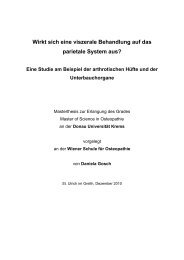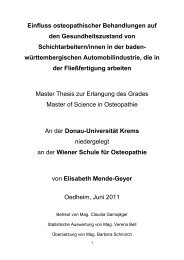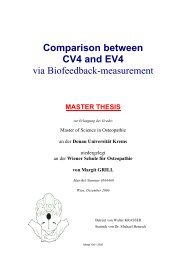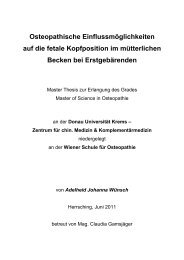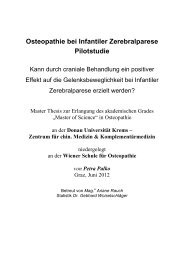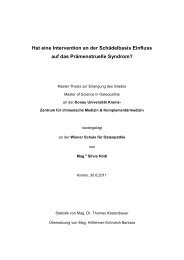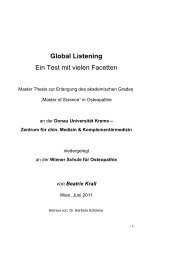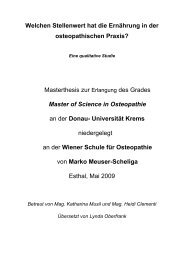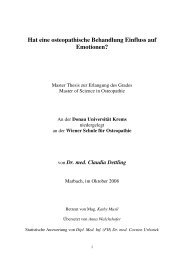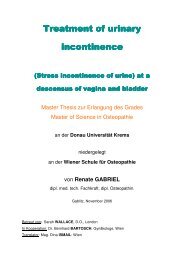2 Der viszeral assoziierte Schulterschmerz - Osteopathic Research
2 Der viszeral assoziierte Schulterschmerz - Osteopathic Research
2 Der viszeral assoziierte Schulterschmerz - Osteopathic Research
Sie wollen auch ein ePaper? Erhöhen Sie die Reichweite Ihrer Titel.
YUMPU macht aus Druck-PDFs automatisch weboptimierte ePaper, die Google liebt.
Viscerally Associated Shoulder Pain<br />
Subjective Perspectives and Diagnostic Procedures – the <strong>Osteopathic</strong> Point of View<br />
it is paramount to also consider both the cervical and the dorsal spine as well as the<br />
inner organs (cf. Diemer/Sutor 2010) since the shoulder area is one of the preferred<br />
areas for referred pain (cf. Goodman/Snyder 2007). “Pain (“referred pain”) in the<br />
shoulder area caused by visceral structures is a well-known fact. Unfortunately, since<br />
there are practically no known assessment procedures, the evaluation is mainly<br />
experience-based” (Diemer/Sutor 2010:97).<br />
Nearly all organs close to the diaphragm refer pain – next to their organ-specific<br />
segments – to the C4 dermatome. Therefore, complaints in this area may hide lifethreatening<br />
diseases such as a heart attack or a Pancoast tumour (Goodman/Snyder<br />
2007). Likewise, a myocardial infarction may produce pain radiating down the left<br />
arm, the neck, the spine or the shoulder area, without the patient experiencing any<br />
pain in the thorax (cf. Buckup 2009; Stevenson/Troijan 2002). Goodman/Snyder<br />
(2007) also indicate that shoulder pain may have its origin in the abdominal or<br />
gastrointestinal area: “Upper abdominal or gastrointestinal problems with<br />
diaphragmatic irritation can refer pain to the ipsilateral shoulder. Peptic ulcer,<br />
gallbladder disease and hiatal hernia are the most likely GI causes of shoulder pain<br />
seen in the physical therapy clinic“ (p. 83). Furthermore, respiratory disorders seem<br />
to increase the risk for shoulder problems. Petchkrua/Harris (2000) conclude from the<br />
case description of a stroke patient that “her symptoms were possibly referred pain<br />
from diaphragmatic irritation transmitted via right C4 sensory axons in the phrenic<br />
nerve, which shares the same dermatome as the right acromion area. This case was<br />
an unusual presentation of pneumonia” and consequently demand “that pneumonia<br />
be considered in the differential diagnosis of shoulder pain“ (p. 827).<br />
In the literature, viscerally associated shoulder pain is explained either as referred<br />
pain or as produced by the fascial system. Regarding the mechanisms of referred<br />
pain where pain appears in an area distant to the original pain location, three<br />
different models try to explain the production of pain: the embryological development,<br />
the convergence of somatic and visceral afferents and direct pressure.<br />
The embryological development shows that already at a very early stage, at around<br />
the third foetal week, the body starts to be organized in layers. From the outside to<br />
the inside, the layers differentiate into dermatome, myotome, sclerotome and<br />
135 | S e i t e



